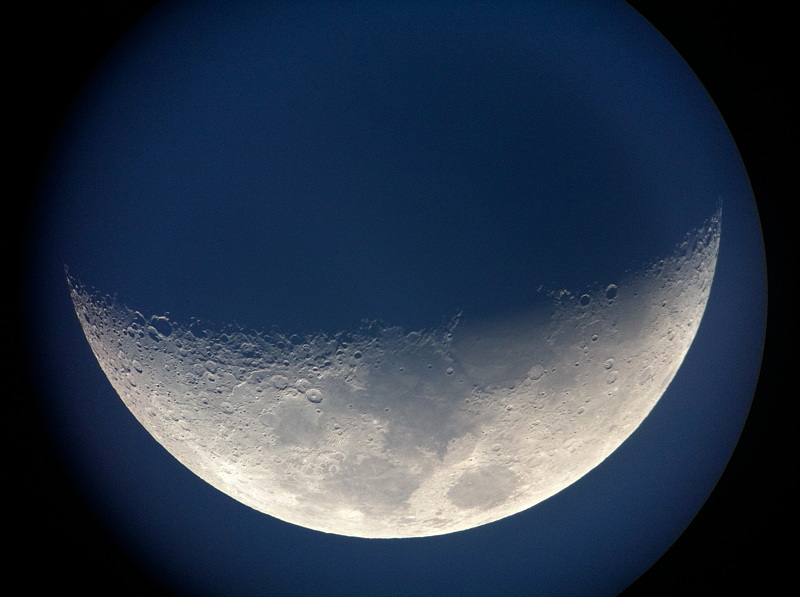
Critters, POD, Mare Humboldtianum, Milky Way
Posted: 15 June 2013
The observatory was opened Friday, 14 June 2013, at 1837 MST, 103°F. The sky was mostly clear, with some pre-monsoon buildups to the southeast, seen here in a cropped photo taken with my D7000 DSLR using the Rokinon 8mm 180° Fisheye Lens:

Since I had the fisheye lens available, I did a self-portrait (not cropped) inside the SkyShed POD:

At 1904 MST, viewed Venus, then Mercury, 83X. Mercury is beginning to show a crescent phase, and was somewhat similar to this evening's crescent moon phase. At 222X, Mercury was a good view. Slewed to the moon for a quick look at 222X.
While waiting for the sky to get darker, I returned to the house to get the LXD55 tripod, which I would be using for photographing the Milky Way with the fisheye lens. As I approached the house I saw one of the three baby Say's Phoebe birds that I have occasionally mentioned. This one was trying to fly. I then saw the second one, which did fly. (The third baby had died the day before.) Click (or tap) the photo below to view a 33 second video (31.4 MB, so be patient while it loads) taken with an iPhone 4 showing both birds:

The video includes sound and you can hear one of the parents talking to me.
I then moved the LXD55 tripod to near the observatory. At 1924 MST, I resumed lunar observing, 222X. Mare Humboldtianum was looking excellent this evening.
I did some lunar afocal imaging with the iPhone 4 mounted on the 8" LX200-ACF using the MX-1 afocal adapter. This image was at 77X:

This is Mare Humboldtianum on the lunar limb (cropped from a full-frame image), 231X:

I continued lunar observing, 222X, at 1950 MST. The views were excellent.
On a recent report I mentioned that I had accidently discovered that the Meade 2" Visual Back had two sections. Using the 2" 24mm UWA eyepiece (83X), I did some tests to determine the differences in magnification with and without the extension. I first tested with the 2" star diagonal. Without the extension, the 24mm eyepiece showed slightly less magnification than with the extension. This allowed the entire lunar disk to be well in the eyepiece field-of-view (FOV). I then removed the diagonal and just used the visual back with the 24mm UWA eyepiece. Without the extension, there was slightly more magnification than when using the diagonal without the extension. With the extension, there was not any significant difference in magnification vs. without the extension. I will continue to use the extension on the visual back unless I need slightly less magnification when using the star diagonal.
I added the extension and star diagonal and resumed lunar observing, 222X. By 2016 MST, I had seen no Kissing Bugs this evening. I decided to stay in the observatory until I saw one. At 2121 MST, took this self-portrait with the fisheye lens:

In the original photo, the head of Scorpius is just visible to the right of the dome. The observatory red lighting is full bright in the f/5, 1 second, ISO 400, photo.
I continued lunar observing, 222X, especially monitoring some mountain shadows along the terminator. At 2042 MST, saw a Kissing Bug in the observatory. After terminating it, I put the telescope to sleep. I left the observatory at 2050 MST.
I returned to the observatory at 2234 MST. I saw no more Kissing Bugs for the remainder of the night. I viewed Saturn, 222X. Cassini Division was an excellent view and there were four moons visible.
Beginning at 2244 MST, I observed the NGC4414 galaxy and the recently discovered supernova SN2013df (which I had imaged on the previous session). The galaxy was more difficult to see this night than the previous night due to the waxing moon still in the sky. But the supernova was visible. Switched to 222X; both the galaxy and its supernova were visible. Switched back to 83X and monitored the galaxy and supernova as the moon got lower in the western sky. Moonset was at 2327 MST. Took a last look at the supernova.
At 2331 MST, slewed to M57 (Ring Nebula) for a quick look, 83X. I then began setting up for Milky Way photography using the D7000 DSLR with 8mm fisheye lens. The camera was mounted on the LXD55, which provided tracking for the long exposures that would be used. I began imaging the sky at 2352 MST using various exposure lengths and ISO values. I had to work around some airplanes that flew overhead. This f/5, 10 minute, ISO 1600, image (cropped from full-frame), was taken at 0036 MST:

Click (or tap) the image to see a larger version. The view goes from Cassiopeia in the north (left) to Sagittarius in the south (right). The camera was pointed slightly to the southeast of the zenith.
While I was doing the sky imaging, clouds began coming in from the west. After completing the imaging at 0047 MST, I began closing the observatory.
The observatory was closed at 0105 MST, 75°F.
Comments are welcome; use the Comments section below, or you can Email Me. Thanks.
Cassiopeia Observatory Home Page